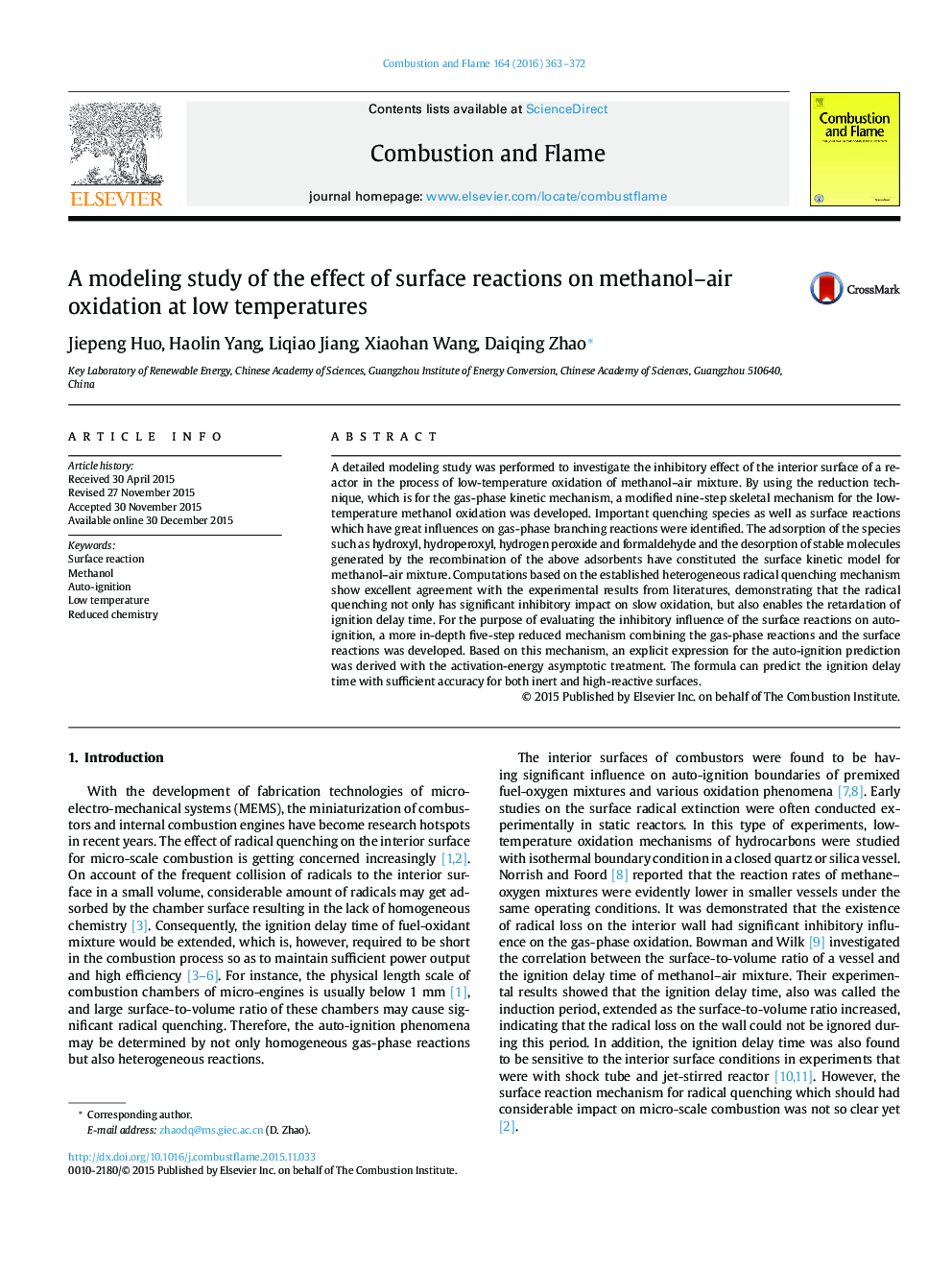| کد مقاله | کد نشریه | سال انتشار | مقاله انگلیسی | نسخه تمام متن |
|---|---|---|---|---|
| 6594327 | 458004 | 2016 | 10 صفحه PDF | دانلود رایگان |
عنوان انگلیسی مقاله ISI
A modeling study of the effect of surface reactions on methanol-air oxidation at low temperatures
ترجمه فارسی عنوان
یک مطالعه مدلسازی اثر واکنشهای سطحی بر اکسیداسیون متانول-هوا در دماهای پایین
دانلود مقاله + سفارش ترجمه
دانلود مقاله ISI انگلیسی
رایگان برای ایرانیان
کلمات کلیدی
واکنش سطح، متانول، اشتعال خودکار، دمای پایین، کاهش شیمی،
ترجمه چکیده
یک مطالعه مدلسازی دقیق برای بررسی اثر بازدارنده سطح داخلی راکتور در فرایند اکسیداسیون کم دما از مخلوط متانول-هوا انجام شد. با استفاده از تکنیک کاهش، که برای مکانیزم سینتیک فاز گاز است، یک مکانیزم اسکلتی 9 مرحله ای اصلاح شده برای اکسیداسیون متانول با دمای پایین توسعه داده شد. گونه های خشک شدن مهم و همچنین واکنش های سطحی که تأثیر زیادی بر واکنش های شاخه ای گاز دارند شناسایی شدند. جذب گونه هایی از قبیل هیدروکسیل، هیدروپروکسیل، پراکسید هیدروژن و فرمالدئید و تجزیه مولکول های پایدار تولید شده توسط نوترکیبی از جاذب های بالا، مدل سینتیکی سطح برای مخلوط متانول-هوا را تشکیل می دهند. محاسبات براساس مکانیزم خنثی سازی رادیکال ناهمگن نشان داده شده با نتایج تجربی از ادبیات موافق عالی است و نشان می دهد که خنک شدن رادیکال نه تنها تأثیر مهمی بر روی اکسیداسیون آهسته دارد بلکه باعث تأخیر زمان تاخیر احتراق نیز می شود. برای ارزیابی تأثیر بازدارندگی واکنش های سطحی در اتمسفر خودکار، مکانیسم کاهش عمق بیشتری در پنج مرحله با ترکیب واکنش های فاز گاز و واکنش های سطحی ایجاد شد. بر اساس این مکانیزم، بیان صریح برای پیش بینی خودکار جوش با استفاده از درمان انرژی آسیمپتوشی انرژی فعال شده است. این فرمول می تواند مدت زمان تاخیر احتراق را با دقت کافی برای هر دو سطح بی اثر و واکنش پذیری پیش بینی کند.
موضوعات مرتبط
مهندسی و علوم پایه
مهندسی شیمی
مهندسی شیمی (عمومی)
چکیده انگلیسی
A detailed modeling study was performed to investigate the inhibitory effect of the interior surface of a reactor in the process of low-temperature oxidation of methanol-air mixture. By using the reduction technique, which is for the gas-phase kinetic mechanism, a modified nine-step skeletal mechanism for the low-temperature methanol oxidation was developed. Important quenching species as well as surface reactions which have great influences on gas-phase branching reactions were identified. The adsorption of the species such as hydroxyl, hydroperoxyl, hydrogen peroxide and formaldehyde and the desorption of stable molecules generated by the recombination of the above adsorbents have constituted the surface kinetic model for methanol-air mixture. Computations based on the established heterogeneous radical quenching mechanism show excellent agreement with the experimental results from literatures, demonstrating that the radical quenching not only has significant inhibitory impact on slow oxidation, but also enables the retardation of ignition delay time. For the purpose of evaluating the inhibitory influence of the surface reactions on auto-ignition, a more in-depth five-step reduced mechanism combining the gas-phase reactions and the surface reactions was developed. Based on this mechanism, an explicit expression for the auto-ignition prediction was derived with the activation-energy asymptotic treatment. The formula can predict the ignition delay time with sufficient accuracy for both inert and high-reactive surfaces.
ناشر
Database: Elsevier - ScienceDirect (ساینس دایرکت)
Journal: Combustion and Flame - Volume 164, February 2016, Pages 363-372
Journal: Combustion and Flame - Volume 164, February 2016, Pages 363-372
نویسندگان
Jiepeng Huo, Haolin Yang, Liqiao Jiang, Xiaohan Wang, Daiqing Zhao,
